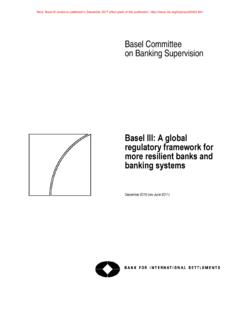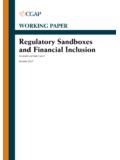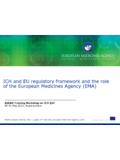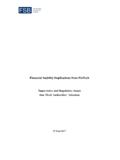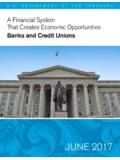Transcription of Financial Regulatory Reform Steering Committee
1 1 Implementing a twin peaks model of Financial regulation in South Africa Published for public comment by the Financial Regulatory Reform Steering Committee 1 February 2013 2 Foreword As outlined in the original policy document, A safer Financial sector to serve South Africa better, published in February 2011, South Africa is committed to the highest standards for regulating the Financial sector. This is because the Financial sector affects all people and companies - who transact through the Financial system, including those who do so from outside South Africa s borders. It affects pensioners, workers, depositors, employers, businesses as all receive, invest, or send money via a Financial institution. The 2008 global Financial crisis has demonstrated the weaknesses of a light-touch Financial Regulatory system.
2 Even though our Financial system weathered the storm, South Africa lost nearly a million jobs as a result of the global contagion that originated from the crisis in the banking and Financial systems of the developed world. Had South Africa experienced a Financial crisis, many more jobs would have been lost. The dilemma that faces most countries is that the Financial sector is globally integrated, but regulated nationally. For this reason, there needs to be minimum international standards and greater co-ordination among different national regulators. Through our participation in multilateral institutions and forums such as the IMF, the G20, the Financial Stability Board, the Basel Committee on Bank Supervision, the International Organisation of Securities Commissions and the International Association of Insurance Supervisors, South Africa has committed itself to implement higher global Financial standards to make the Financial sector safer and better.
3 It is against this background that we have committed ourselves to a wide-ranging set of reforms. One of the most important strands of this work has been the effort to improve the institutional structures to support Financial regulation. These reforms were announced in the original 2011 policy document. The document proposed a shift to a twin peaks system of Financial sector regulation, a proposal which was adopted by Cabinet in July 2011. 3 The main objective of the policy is the development of institutions to deal with system-wide macro-prudential risks. This will be achieved by separating the oversight of market conduct regulation (regulating how firms conduct their business, design and price their products, and treat their customers) from prudential regulation (regulating Financial institutions solvency and liquidity).
4 This document provides more detailed proposals on implementing the decisions arising from the original 2011 policy document. It outlines the most important building blocks of the new system, presents the governance and accountability framework, and sets out the approach to prudential and market conduct regulation. It was prepared by the Financial Regulatory Reform Steering Committee (FRRSC)1, which comprises of senior officials from the three key Financial Regulatory institutions (South African Reserve Bank, Financial Services Board and National Treasury). The report, together with the original 2011 policy document, A safer Financial sector to serve South Africa better, is the basis for consultation with the public and key stakeholders, after which this document will be revised and presented to the Governor of the South African Reserve Bank and myself for further consideration.
5 Thereafter I will prepare and table the legislation necessary for the implementation of the twin peaks model of regulation. An effective Regulatory framework requires strong coordination by regulators. This document is a testament to the strong partnership between the National Treasury, the South African Reserve Bank, and the Financial Services Board, which together with the National Credit Regulator, are working together to bring about a better, safer and more inclusive Financial sector to serve all South Africans. Pravin Gordhan Minister of Finance 1 The task team, known as the Financial Regulatory Reform Steering Committee (FRRSC), is co-chaired by Lesetja Kganyago, Deputy Governor of the South African Reserve Bank; Ismail Momoniat, Deputy Director-General: Tax and Financial Sector Policy of the National Treasury; and Dube Tshidi, Chief Executive Officer of the FSB 4 Contents Foreword 2 Overview 6 1.
6 Setting the scene 14 Moving towards a twin peaks model 14 The global context for Regulatory Reform 20 Assessment of costs and benefits 24 Conclusion 29 2. Governance and accountability framework 30 Introduction 30 Governance pillars 30 The prudential regulator s governance framework 32 The market conduct regulator s governance framework 33 Summary 34 3. Strengthening Financial stability oversight 35 Introduction 35 Financial stability oversight 35 Summary 42 4. Prudential regulation and supervision 43 Introduction 43 Objective and mandate 43 Regulatory and supervisory principles 44 Regulatory and supervisory approach 45 Summary 46 5 5. Market conduct regulation and supervision 47 Introduction 47 Objective and mandate 47 Regulatory and supervisory principles 48 Regulatory and supervisory approach 49 Supervisory tools 54 Summary 56 6.
7 Crisis management and resolution 58 Introduction 58 Objectives and principles of a crisis resolution framework 58 The resolution authority 59 Scope of the resolution framework 60 Funding arrangements for resolution 66 Cross-border cooperation in resolution 67 Exiting the resolution process 68 Summary 68 7. Enforcement 69 Introduction 69 Prudential Regulatory environment 69 Market conduct Regulatory environment 71 Regulator and adjudicative independence 72 Cooperation 72 Combating money laundering and terrorism financing 73 Summary 74 8. Implementation and next steps 74 Abbreviations 75 6 Overview In 2007, Government launched a formal review of South Africa s Financial Regulatory system. This review was expanded in 2009 to take into account the lessons learnt from the global Financial crisis that began in 2008.
8 This work culminated in the Minister of Finance publishing a policy document, A Safer Financial Sector to Serve South Africa Better, in 2011. The policy document noted that the domestic Financial sector had weathered the global Financial crisis relatively well due to the country s sound macroeconomic fundamentals and a robust Financial Regulatory framework. However, it cautioned against becoming complacent and proposed to move towards a twin peaks model of Financial regulation. Speaking about the proposed change during his 2012 Budget Speech, the Minister of Finance said: As announced last year, we intend to shift towards a twin peaks system for Financial regulation, where we separate prudential from market conduct supervision of the Financial sector. Consultations will continue this year, with a view to tabling legislation in early The prudential regulator s objective will be to maintain and enhance the safety and soundness of regulated Financial institutions.
9 Prudential safety and soundness imply the continued Financial health of regulated institutions. The prudential regulator, which will form part of the South African Reserve Bank ( the Bank ), will be responsible for the prudential regulation and supervision of banks and insurers. In this context, prudential regulation includes both micro and macroprudential aspects (see box below). The market conduct regulator s objective will be to protect consumers of Financial services and promote confidence in the South African Financial system. This responsibility will be carried out by the Financial Services Board, which will be transformed in order to meet its revised mandate with regards to market conduct regulation. 2 National Treasury (2012) 2012 Budget Speech (Pretoria: National Treasury, 22 February 2012), page 28.
10 7 Macroprudential and microprudential The term macroprudential regulation or supervision refers to the analysis of strengths and vulnerabilities of Financial systems as a whole (systemic risk). Macroprudential assessments cover a wide range of economic and Financial circumstances and information, such as gross domestic product growth and inflation, the structure of a Financial system, and qualitative information on the institutional and Regulatory framework. The term microprudential refers to the safety and soundness of individual Financial institutions. Government, through the Minister of Finance, is responsible for the policy framework for the regulation of the Financial system. In terms of this framework, the Bank will take a leading role in promoting Financial system stability by becoming the systemic regulator for the South African Financial system, and supervising and monitoring the Financial system to give effect to the Financial stability objective.










